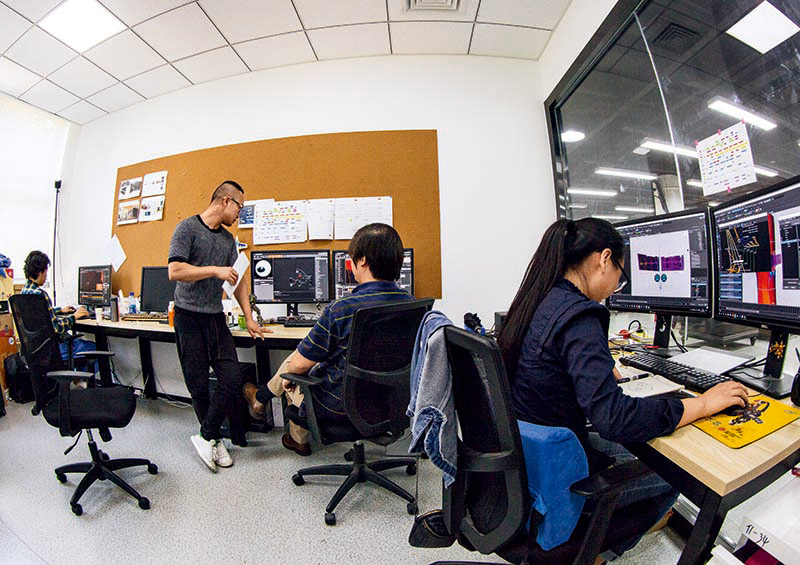Virtually Blooming Animation

This year’s Venice International Film Festival was a boon to virtual reality (VR) content providers worldwide: The time-honored festival announced the first-ever competition for films made in VR. A total of 22 VR movies were nominated, including two VR animated films from China—Free Whale and The Dream Collector. The nominations helped the creators of these films attain greater popularity in their home country and the films be more widely enjoyed. Despite ups and downs in recent years, producers are still riding the VR wave in hopes of emerging as one of the first heavyweights of the new medium.

Free Whale, the first animated production from Sandman Studios, tells the story of Shem, a boy from the future who meets a robot whale during his journey to collect samples of artificial intelligence in space. courtesy of Sandman Studios
Melding Tech and Art
“When the whale jumps out of the water, it looks so real,” exclaimed Lou Yanxin’s parents after watching Free Whale. The animated VR film was the first production of Sandman Studios, which Lou founded. Most of the 11 people in the company were born in the 1990s and accrued rich experience in areas like gaming and dramatic production. However, lacking experience shooting live-action films, they decided to create VR animation with computer graphics (CG) technology.
According to Lou, it is hard to explain the VR experience; one must personally experience it. “My colleagues and I went all-in on the industry after our first VR experience,” declares Lou.
The 3D content produced in VR can have much greater potential than 2D and provide more space for creators. “Traditional movies provide a comparatively fixed angle of view since each shot focuses in only one direction,” explains Lou. “A VR film is more like a theatrical play in which four or five characters move simultaneously. Moreover, spectators feel like part of the play rather than removed from it.”

Lou Yanxin, founder of Sandman Studios, introduces VR concepts utilized in the animated film Free Whale. by Chen Jian
The immersive VR experience can enhance sensory pleasure, but at the same time, divert the audience’s attention. Shooting and editing techniques of traditional films are no longer applicable to VR animation. Filmmakers are still working hard to explore new techniques and rules for VR movies.
Free Whale features a single shot throughout the entire animated film, which allows viewers to closely track the motions of the lead character. The Dream Collector adopts a three-act structure, and the screen goes black at the end of an act.
The development of a more interactive experience has made VR more immersive, but such technology hasn’t yet been seized by VR animators due to their need for a consistent storyline. At first, Free Whale was designed to let the audience touch the whale on the screen to switch to a first-person point-of-view as the lead character meets the whale for the first time. However, the feature only confused the audience. Ultimately, the final version abandoned interactive elements altogether.
“The interactive experience must be considered when the screenplay is written,” notes Lou. “Instructions are also necessary, just like how computer games have tutorials.”
Taiji, another animated VR film in the Sandman Studios pipeline, will provide an interactive experience throughout the film, in which characters’ movements and surroundings on screen will change based on the audience’s viewing angle.
Typically, a VR animated film stretches only up to a dozen minutes. Constant updating of the necessary tools and hardware is hindering filmmakers from attempting a feature-length VR film. Sandman Studios must completely reinstall its design software every two months in order for it to function optimally.

Founded in September 2016, Sandman Studios employs 11, most of whom were born in the 1990s and accrued rich experience in areas like gaming and dramatic production. by Chen Jian
“After we update the software, work that might have taken two weeks before can be accomplished in two days,” Lou says. “Every time it’s a no-brainer.”
Furthermore, most VR headsets remain heavy and cumbersome and lack ultra-high resolution. Users can get dizzy after extended usage. Such concerns have also quashed hopes for feature-length VR films. In the eyes of Lei Zhengmeng, producer of The Dream Collector and cofounder of Pinta Studios, the ideal length of a VR film should be about 10 minutes, so VR animation is suited to tell a “short but moving story.”
The Dream Collector tells the heartwarming story of an old man who collects and fixes discarded objects before giving them to others, through which the dreams preserved in those objects are also passed on. Director Mi Li drew inspiration from a real-life encounter he had with an elderly scavenger he met on the street. With the animated film, he hopes to remind people of dreams they have abandoned.
Another VR animated film soon to be released by Pinta Studios is Shennong: Taste of Illusion, a fairy tale about Shen-nong, the legendary father of Chinese herbal medicine, who is known for tasting herbs to discover their qualities. According to Lei, a scene in which Shennong fights illusory monsters after eating a poisonous herb is particularly breathtaking in VR.

Lei Zhengmeng and his colleagues work on an animated film titled Shennong: Taste of Illusion, a fairy tale about Shennong, the legendary father of Chinese herbal medicine. Founded in June 2016, Pinta Studios now employs nearly 30 people. by Chen Jian
Big VR Business
In mid-September 2017, The Dream Collector, which cost 2.5 million yuan (about US$378,170) to make, was released through online VR platforms and received a million views within 27 hours of its release. The animated film affords viewers a 360-degree panoramic video on their smartphones. Moreover, using a VR headset, viewers can see different images as they move their heads or eyes, which greatly enhances the experience.
However, a VR headset and a computer that can handle VR videos can cost over 10,000 yuan (about US$1,510), a price point that has kept VR removed from ubiquity in ordinary households.

Lei Zhengmeng, co-founder and CEO of Pinta Studios. He believes that VR is an amazing integration of art and technology. by Chen Jian
Only a handful of public theaters have attempted to screen VR films. The overwhelming majority of VR experience centers around China focus on providing VR games. Not until June 2017 did Beijing welcome its first VR cinema. However, domestic business giants including Gome and Wanda have begun sinking more money into construction of VR cinemas.
Since 2016, China’s VR market has undergone explosive growth followed by a sharp decline. In this context, many VR content producers were left on the brink of bankruptcy. Even when investors were bullish on VR, most capital ended up with hardware manufacturers rather than content producers. Compared to its peers, Pinta Studios enjoyed a smooth start. When Mi Li, who had served as executive director of the famous Chinese animated film Monkey King: Hero Is Back, joined, the company found itself with a sharper competitive edge. Still, co-founder Lei Zhengmeng visited dozens of investors before eventually securing an angel investment of six million yuan (about US$906,820).
Pinta Studios is already looking at more diversified operations. Capitalizing on its fame earned at the Venice International Film Festival, The Dream Collector has generated revenues through copyright sales, built-in advertisements and derivative product development. Pinta Studios has collaborated with more than 20 makers of products such as liquor, nuts and umbrellas to engage in crowdfunding. It joined hands with the Chemical Industry Press to publish a children’s picture book, and almost all of the 6,000 available copies have sold out. The online version of The Dream Collector has built-in advertisements for 13 brands. Lei hopes that such monetizing attempts will boost the confidence of his partners.
Lou Yanxin is promoting VR content production in his own way: by organizing film exhibitions. Since 2016, he has organized three VR film exhibitions under the banner of “Sandbox Show,” which have not only offered a communication platform for industry insiders, but also helped the public better understand VR. He plans to hold a large exhibition of VR works from around the world in June 2018, flanked by forums, workshops and trade fairs. Because he knows China’s VR industry remains immature, Lou hopes that such an exhibition will provide a platform for VR filmmakers, investors and distributors to exchange ideas with each other.